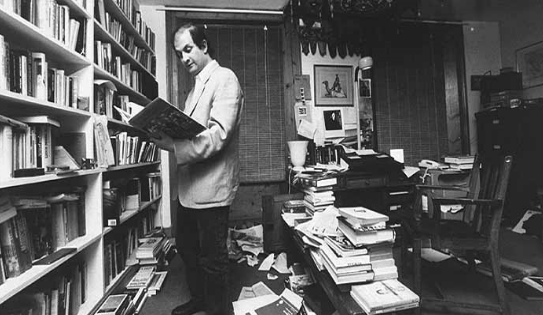'Midnight's Children' Turns 30
 Anvar Alikhan writes in Outlook:
Anvar Alikhan writes in Outlook:
It’s now thirty years since Midnight’s Children was published. When Salman Rushdie first sent the manuscript to the publishers, the initial reaction was damning: “The author should concentrate on short stories”. Fortunately, they ultimately changed their minds and the book, of course, went to become the most celebrated of Booker Prize winners. Rushdie was a few years senior to me in Bombay’s Cathedral School and one place I often remember seeing him as a kid was at the Metro cinema: we were members of something called the Metro Cub Club, which screened film shows for kids on Saturday mornings. Many years later, reading Rushdie’s interview in The Paris Review, I discovered that he believes the turning point in his life as a writer was watching The Wizard of Oz at the Metro as an 11-year-old: he went straight home and wrote his first story, ‘Over the Rainbow’, about a little boy who’s walking down a Bombay footpath when he suddenly finds the beginning of a rainbow, with steps cut into it, which takes him up into a fairy-tale world in the sky. By some freak chance I, too, saw The Wizard of Oz at the Metro Cub Club, which means I must have been sitting just a few seats away while one of the world’s great literary epiphanies was being shaped.
So what was Rushdie like as a kid? His classmate, adman and occasional actor Keith Stevenson—immortalised in Midnight’s Children as ‘Glandy Keith Colaco’, the bully—remembers him as a very bright, aloof, slightly effete kid, who wore expensive silk shirts to class and wrote with a fancy Mont Blanc pen. “We once put sulphuric acid in his ink-pot,” Stevenson recalled years later. “So the next time he filled that damn Mont Blanc, it melted in front of his eyes”. Darab Talyarkhan, a childhood friend, remembers him as being hopeless at sports, but a talented writer, clever with words, and a favourite of his English teachers: when the class was once asked to compose limericks, for example, the other boys managed one or two; Rushdie wrote over thirty. Talyarkhan also offers an interesting example of Rushdie’s particularly vivid imagination: aged 11, he invented a game at school called ‘submarines’, where four friends would form a human submarine, with Rushdie in the lead, pumping his arms noisily, like pistons, while the others followed, kicking their legs outwards. This weird submarine would loudly make its way around the school premises during lunch-break every day, drawing jeers from boys. But Rushdie was quite impervious to the jibes: “Those morons can’t see us,” he would say superciliously, “because we are a submarine travelling deep below the surface.”
Rushdie has a quirky thing about the names of his characters. In Shalimar the Clown, for example, he whimsically named his character Max Ophuls—like the well-known film director, but no connection; when asked why he didn’t simply invent a new name for the character instead, he shrugged and replied, “I don’t know. Names stick.” Midnight’s Children is filled with names that evidently ‘stuck’, and when the book was first released, the biggest game in Mumbai was trying to figure out who-was-supposed-to-be-who. ‘Cyrus-the-Great’, for example, was apparently based loosely on Cyrus Guzder, the conservationist and chairman of AFL, whom Rushdie obviously admired in school. ‘Eyeslice’ and ‘Hairoil’ were his buddies, Fudli and Darab Talyarkhan, the former getting his nickname from the way his eyes stretched wide when he smiled and the latter from the quantities of Glostora hair-oil he applied—but their surname becomes ‘Sabarmati’, and their dashing naval officer father takes you sideways into the famous Nanavati murder case of the ’50s. ‘Evie Burns’ draws upon Beverly Burns, an Australian girl, apparently the first girl Rushdie ever kissed. And ‘Masha Miovic’ owes something to a Yugoslavian girl whom he had an adolescent crush on and who, ironically, doesn’t remember today who Salman Rushdie was (prompting the author to comment wryly, “Between the adored and the adorer falls the shadow”). But the big question, of course, is, who was the book’s protagonist, ‘Saleem Sinai’? ...
Click here to read the rest.

